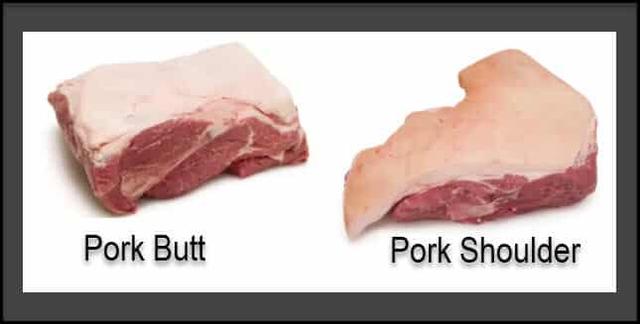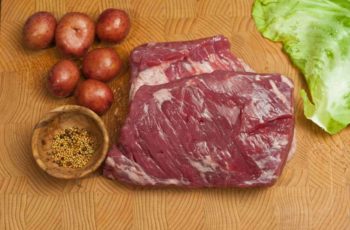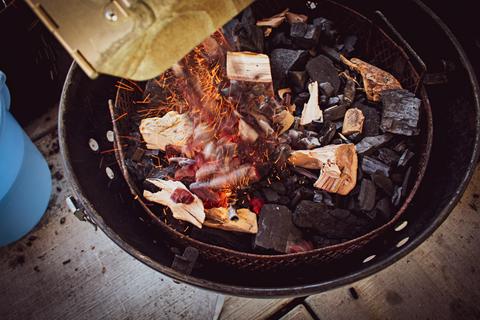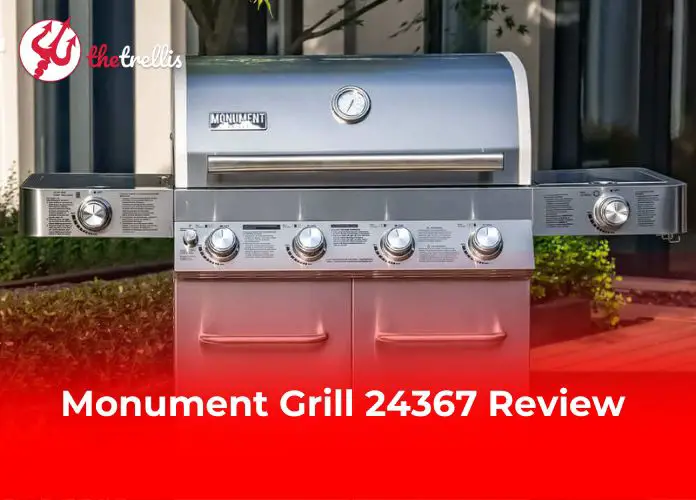“Mastering the art of cooking brisket involves a crucial decision: fat side up or down? Unveiling the secrets behind this age-old debate, we explore the pros and cons of each technique. Whether you’re a seasoned pitmaster or a beginner, discover the ultimate method to achieve tender, flavorful brisket that will have everyone asking for seconds.”
What Is TheBrisket Fat Cap?
The brisket fat cap refers to the thick layer of fat that runs across one side of the brisket. This fat sits directly under the cow’s skin and is usually about one inch thick on a full packer brisket. When preparing a brisket, it is important to trim this fat cap to a quarter-inch thickness for optimal results. Trimming the fat cap helps prevent it from becoming partially cooked and unenjoyable, while also shaping the brisket to be a uniform size.

When it comes to cooking the brisket, whether you should cook it fat side up or down depends on your style of smoking and the type of smoker you are using. For vertical-style smokers like Weber Smokey Mountain, electric smokers, or gas smokers, it is recommended to cook the brisket with the fat side down. This helps shield the meat from direct heat.
On the other hand, if you are using an offset smoker or pellet grill that offers more indirect heat, cooking the brisket with the fat side up may be preferred. However, this method may make it difficult to see if the bark is forming properly on the surface of the meat that is against the grill grates.
Ultimately, choosing whether to cook your brisket fat side up or down depends on your personal preferences and the specific characteristics of your smoker. Experimenting with different methods can help you determine which approach gives you the best results according to your taste preferences.
Should I Trim The Fat Off The Brisket?
When it comes to trimming the fat off a brisket, there is a balance to be struck. While you don’t want to leave all of the fat on the brisket, as it won’t render properly and can result in an unpleasant texture, removing all of the fat can lead to overcooked meat. The ideal approach is to trim the fat down to about a quarter-inch thick layer. This allows for some flavor and moisture from the fat to infuse into the meat during cooking while also preventing excessive fattiness. Additionally, trimming the brisket involves shaping it to ensure even cooking and removing any thin or easily burnt parts. It’s important not to be afraid of trimming off some excess fat and meat, as this will result in a better final product.
If you have trimmed off a significant amount of fat from your brisket, you can repurpose it rather than throwing it away. You can use a meat grinder to turn the trimmings and extra fat into homemade sausage or burgers. Alternatively, you can render down the fat by cooking it in a slow cooker on medium-low heat until it completely melts. This rendered beef tallow can be used for various purposes.
In conclusion, when trimming a brisket, aim for a quarter-inch-thick layer of fat while also shaping the meat for even cooking. Don’t be afraid to remove excess fat and meat that won’t render properly or could burn easily. Consider repurposing any trimmings by grinding them into sausage or burgers or rendering them down into beef tallow.

What Do I Do With The Trimmings?
When it comes to trimming the fat cap off your brisket, it’s important to find a balance. Leaving too much fat on the brisket won’t allow it to render properly and can result in an unpleasant texture. On the other hand, removing all of the fat can cause the meat underneath to overcook and become dry. It’s recommended to trim the fat cap to about a quarter-inch thickness while also shaping the brisket for even cooking.
As for whether to cook brisket fat side up or down, it largely depends on your style of smoker. If you’re using a vertical-style smoker, electric smoker, or gas smoker where there is direct heat source below the meat, placing the fat side down can help shield the meat from excessive heat. However, if you have a smoker that offers more indirect heat like a traditional offset smoker or pellet grill, cooking the brisket fat side up may be preferred.
There are arguments for both methods. Cooking with the fat side up can help keep the meat moist by allowing the rendered fat to drip over it. However, meat doesn’t absorb that rendered fat due to its moisture content. Cooking with the fat side down can protect the bottom of the meat from drying out and overcooking.
Ultimately, it’s important to consider your specific smoker and personal preferences when deciding whether to cook brisket fat side up or down. Experimentation is key in finding what method gives you the best results for your desired flavor and texture.
Do YouSmokeBrisket Fat Side UpOr Down?
When it comes to smoking brisket, the question of whether to cook it fat side up or down is a common debate among barbecue enthusiasts. The answer largely depends on the type of smoker you are using. If you have a vertical-style smoker, electric smoker, or gas smoker, it is recommended to cook the brisket fat side down. This helps shield the meat from the direct heat source and prevents it from drying out. However, if you are using a traditional offset smoker or pellet grill that offers more indirect heat, you may want to cook the brisket fat side up. This allows the fat cap to help shelter the meat from excessive top heat.
The fat cap on a brisket is the thick layer of fat that runs across one side of the meat. It is usually one inch thick on a full packer brisket and sits directly under the cow’s skin. When trimming a brisket, it is important to remove some of this fat but not all of it. Leaving too much fat can result in an unrendered layer that won’t be enjoyable to eat, while removing all of the fat can cause the meat underneath to overcook.
In terms of wrapping your brisket in butcher paper or aluminum foil, there are differing opinions on whether to place the fat side up or down. Some recommend placing it up so that the brisket can sit in its collected juices, but this can cause the bark (the flavorful crust on the surface) to soften. It is generally recommended to wrap with the fat side down in order to preserve as much bark as possible.
When cooking a brisket in a slow cooker with liquid, it is best to place it fat side up so that the liquid surrounds and flavors the meat.
Overall, there isn’t one definitive answer for whether to cook brisket fat side up or down. It depends on your personal preference and the type of smoker you are using. Experimentation and finding what works best for you is part of the enjoyment of smoking brisket.
When To Cook BrisketFat Side Up
When cooking a brisket in a vertical-style smoker, electric smoker, or gas smoker, it is recommended to cook the brisket fat side down. This helps shield the surface of the meat from the heat source and prevents it from drying out. However, if you are using a traditional offset smoker or pellet grill that offers more indirect heat, it is preferable to cook the brisket fat side up.
When wrapping brisket in butcher paper or aluminum foil, some people recommend placing the fat side up so that the brisket can sit in the collected juices. However, this can cause the bark to soften. It is generally recommended to wrap the brisket with the fat side down to preserve the bark as much as possible.
If you are cooking a brisket in a slow cooker, it is best to put it fat side down. This helps protect the meat from direct heat and keeps it moist during the cooking process.
Overall, the decision of whether to cook brisket fat side up or down depends on your style of smoker and personal preferences. It is important to consider how your specific smoker distributes heat and choose accordingly.
When To Cook Brisket Fat Side Down
When cooking brisket, there are a few factors to consider when deciding whether to cook it fat side down or up. If you are using a vertical-style smoker, electric smoker, or gas smoker, it is recommended to cook the brisket fat side down. This helps shield the surface of the meat from the heat source and prevents the bottom of the brisket from drying out and overcooking.
On the other hand, if you are using a traditional offset smoker or pellet grill that offers more indirect heat, you may want to cook the brisket fat side up. This allows the rendered fat to drip over the meat and potentially keep it moist.
When wrapping brisket in butcher paper or aluminum foil, some people recommend placing it fat side up so that it can sit in any collected juices. However, this can cause the bark on the surface of the meat to soften. It is generally recommended to wrap the brisket with fat side down to help preserve the bark as much as possible.
If you are cooking brisket in a slow cooker with liquid, it is best to place it fat side up so that the liquid surrounds and helps moisten the meat.
Ultimately, the decision of whether to cook brisket fat side down or up depends on your personal preferences and style of smoker or cooking method. Experimentation may be necessary to find what works best for you.
Wrapping It Up
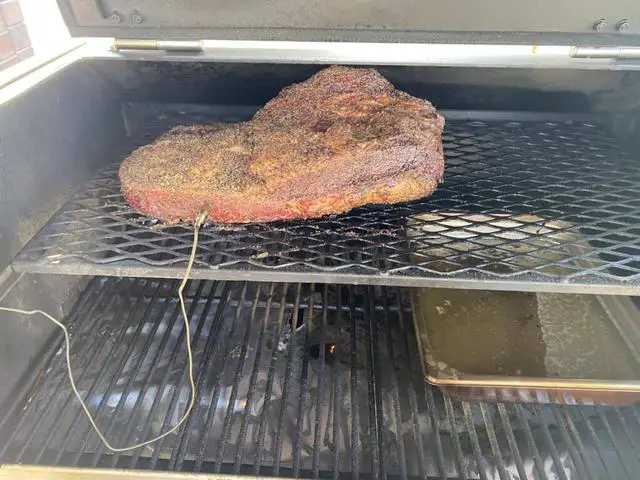
Wrapping It Up
When it comes to cooking a corned beef brisket, the placement of the fat side largely depends on your method of cooking. If you’re using a vertical-style smoker, electric smoker, or gas smoker, it’s recommended to place the fat side down to shield the meat from the heat source. On the other hand, if you have an offset smoker or pellet grill that provides more indirect heat, placing the fat side up is preferred.
Similarly, when wrapping brisket in paper or foil, it’s best to consider preserving the bark. Some people recommend placing the fat side up so that the brisket can sit in collected juices, but this can soften the bark. To preserve the bark as much as possible while wrapping, it is generally recommended to place the fat side down.
If you’re cooking a brisket in a slow cooker with liquid, it is advised to place the fat side up so that the liquid surrounds and helps keep the meat moist.
Overall, choosing whether to place the fat side up or down depends on your specific cooking method and preferences. Experimenting with both methods can help you determine which one gives you the best results.
FAQs:
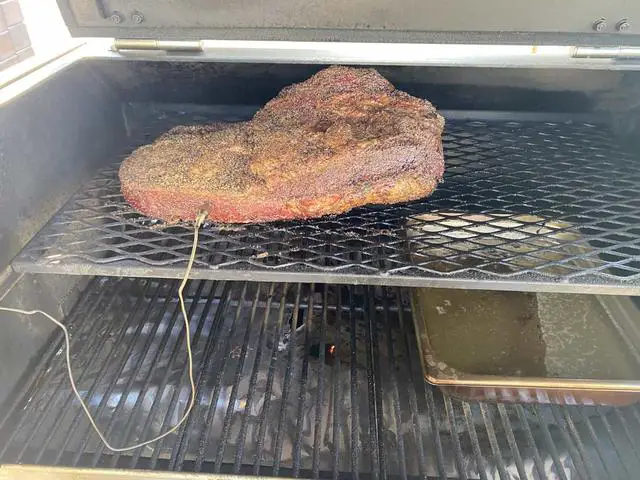
1. When cooking a corned beef brisket, does the fat side go up or down?
The fat side of a corned beef brisket should go up when cooking it. This allows the fat to render down and baste the meat, keeping it moist and flavorful.
2. Should I put the fat side up or down when wrapping brisket in paper?
When wrapping brisket in butcher paper, it is recommended to place the fat side down. This helps preserve the bark and prevents it from becoming too soft.
3. If I’m cooking a brisket in a slow cooker, should I put it fat side up or down?
When using a slow cooker to cook brisket, it is best to place the fat side down. This helps protect the meat from direct heat and keeps it tender and moist.
Question: When cooking a corned beef brisket, does the fat side go up or down?
When cooking a corned beef brisket, the fat side should go up or down depending on your personal preference and cooking method. Some people believe that placing the fat side up allows the fat to melt and baste the meat, resulting in a juicier brisket. Others prefer to place the fat side down to protect the meat from direct heat and prevent it from drying out.
If you are using a vertical-style smoker, electric smoker, or gas smoker, it is recommended to place the fat side down to shield the meat from the heat source. However, if you are using an offset smoker or pellet grill that offers more indirect heat, you may want to put your brisket fat side up.
Ultimately, the decision of whether to cook the brisket fat side up or down depends on your style of smoking and personal preference. Experimenting with different methods can help you determine which way yields the best results for your taste.
Question: Should I put thefat side upor down when wrapping brisket in paper?
When wrapping your brisket in butcher paper or aluminum foil, the question arises whether to put the fat side up or down. Some people recommend placing the fat side up so that the brisket can sit in the collected juices, but this can cause the bark to become completely softened. On the other hand, putting the fat side down when wrapping helps preserve the bark as much as possible. It’s important to note that Michael Haas prefers putting the fat side up when wrapped, but he uses offsets and pellet grills. Ultimately, it depends on personal preference and the type of smoker being used.
Question: If I’m cooking a brisket in aslow cooker, should I put itfat side upor down?
When cooking a brisket in a slow cooker, the fat side should be placed down. This helps to protect the meat from direct heat and allows it to cook evenly. Placing the fat side up can result in the meat becoming dry and overcooked. By placing it fat side down, the fat will render and baste the meat as it cooks, keeping it moist and flavorful.
Additionally, placing the fat side down in a slow cooker allows for better bark formation. The bark is the flavorful crust that forms on the outside of the brisket during cooking. By having the fat side down, you ensure that the surface of the meat is exposed to direct heat and can develop a crispy and flavorful bark.
Overall, when using a slow cooker to cook a brisket, it is best to place it fat side down to ensure even cooking, moisture retention, and optimal bark formation.
In conclusion, whether to cook brisket fat side up or down is a matter of personal preference. Cooking it fat side up may result in juicier meat, while cooking it fat side down can create a flavorful crust. Ultimately, experimenting with both methods will help determine the best approach for achieving your desired results.
Learn More About Grilling
If you want to learn more about grilling, check out these other helpful resources!

